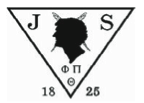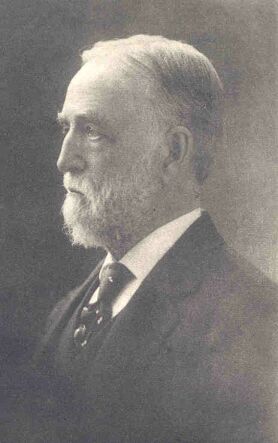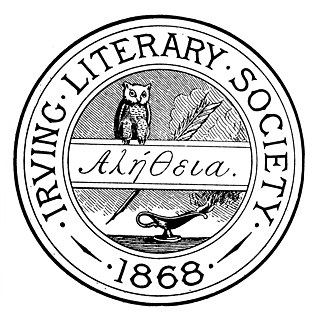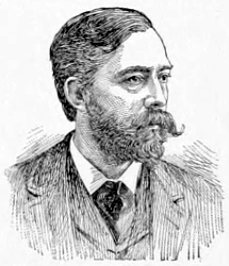
The Jefferson Literary and Debating Society is the oldest continuously existing collegiate debating society in North America, having been founded on July 14, 1825, in Room Seven, West Lawn. Named after founder of the University, Thomas Jefferson, the society regularly meets on Friday evenings at Hotel C in the Academical Village, referred to as "Jefferson Hall", "Jeff Hall", or simply "The Hall".

Cornelliana is anything related to Cornell University, an Ivy League university founded in 1865 in Ithaca, New York. The university has a considerable number of traditions, legends, and lore unique to the university that have developed over its existence, which spans over 150 years.

The history of Cornell University begins when its two founders, Andrew Dickson White of Syracuse and Ezra Cornell of Ithaca, met in the New York State Senate in January 1864. Together, they established Cornell University in Ithaca, New York, in 1865. The university was initially funded by Ezra Cornell's $400,000 endowment and by New York's 989,920-acre (4,006.1 km2) allotment of the Morrill Land Grant Act of 1862

The Washington Literary Society and Debating Union is a literary and debating group at the University of Virginia in Charlottesville. While its current incarnation is modern, the society has roots back to the first decade of operation of the University and was founded in the mid-1830s.

Willard Straight Hall is the student union building on the central campus of Cornell University in Ithaca, New York. It is located on Campus Road, adjacent to the Ho Plaza and Cornell Health.

Linonia is a literary and debating society founded in 1753 at Yale University. It is the university's second-oldest secret society.

The Philodemic Society is a student debating society at Georgetown University founded in 1830 by Father James Ryder, S.J. The Philodemic is among the oldest such societies in the United States, and is the oldest secular student organization at Georgetown. The society's motto, "Eloquentiam Libertati Devinctam" reminds its members that they are pursuing Eloquence in Defense of Liberty.

Prudence Risley Residential College for the Creative and Performing Arts, commonly known as Risley Residential College, Risley Hall, or just Risley, is a program house at Cornell University. Unlike most other dormitories on campus, Risley is a residential college; house members, or "Risleyites," have some say in the administration of the residence hall, can continue to reside there as long as they are enrolled at Cornell, are encouraged to eat together at the in-house dining hall, and participate in educational activities such as guest lectures within the dormitory.

Francis Miles Finch was an American judge, poet, and academic associated with the early years of Cornell University. One of his poems, "The Blue and the Gray", is frequently reprinted to this day.
College literary societies in American higher education were a distinctive kind of social organization, distinct from literary societies generally, and they were often the precursors of college fraternities and sororities. In the period from the late eighteenth century to the Civil War, collegiate literary societies were an important part of campus social life. College literary societies are often called Latin literary societies because they typically had compound Latinate names.

Wesley Newcomb (1818–1892) was an American physician and a malacologist who specialized in land snails.
John Anthony Hartell (1902–1995) was an American artist of first the Impressionist and later the Modern styles. He was born in Brooklyn. As an artist, Hartell gives shape and form to those aspects which are least substantial: light, atmosphere, and memory.

Ernest George Merritt was Dean of the Graduate School, Cornell University; Chair of the Physics Department.

Bruce Hyde of Waitsfield in Vermont's Mad River Valley and Ithaca, New York is an American former champion runner, competitive in the 1500m/Mile and other events. He is an artist and musician with the rock and roll band LOFTS.

Henry "Harry" Falkenau of Chicago, Illinois was a musician, music critic and bibliophile who operated an antique book shop at 167 Madison Street, Chicago, Illinois specializing in Americana, first editions, as well as metaphysics. He was also an early defender of Walt Whitman's poetry, taking a First Amendment stand against censorship soon after Leaves of Grass was declared obscene in 1882.
The Cornell Catholic Community is the Catholic organization and parish at Cornell University, providing worship services and community for Catholic students. Its current director is Father Daniel McCullin.

The Irving Literary Society was a literary society at Cornell University active from 1868 to 1887. The U.S. Bureau of Education described it as a "purely literary society" following the "traditions of the old literary societies of Eastern universities." During the period when the Cornell literary societies flourished, the Irving and its peers produced literature at a rate higher than the campus average for the next generation, leading commentators at the turn of the 20th century to question whether academic standards had fallen since the university's founding. Named after the American writer Washington Irving, the Irving Literary Society was founded on October 20, 1868, shortly after Cornell opened. Past members who went on to prominent careers included Judge Morris Lyon Buchwalter, Senator Joseph Benson Foraker, and the journalists John Andrew Rea and Francis Whiting Halsey. The Irving's last public meeting was held on May 23, 1887. After that it ceased to exist as a Cornell University student society. However, the New York Alpha Chapter of the Phi Kappa Psi undergraduate fraternity at Cornell claims to have "served as steward of the Irving Literary Society since 1888".

The Enosinian Society is a debate and literary society founded in 1822 during the first semester of the Columbian College. It is currently known as The George Washington University Debate & Literary Society.

Simon Henry Gage was a professor of anatomy, Histology, and Embryology at Cornell University and an important figure in the history of American microscopy. His book, The Microscope, appeared in seventeen editions. In 1931, a volume of the American Journal of Anatomy was dedicated to Gage on the occasion of his eightieth birthday.



















